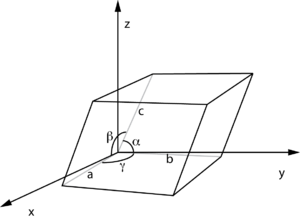Fractional coordinates
In crystallography, a fractional coordinate system is a coordinate system in which the edges of the unit cell are used as the basic vectors to describe the positions of atomic nuclei. The unit cell is a parallelepiped defined by the lengths of its edges a, b, c and angles between them α, β, γ as shown in the figure below.

Conversion to cartesian coordinates
To return the orthogonal coordinates in ångströms from fractional coordinates, one can multiply the fractional coordinates by the operation matrix below:[2][3]
where a, b, c, α, β, and γ are the unit-cell parameters. Also, v is the volume of a unit parallelepiped defined as:
For the special case of a monoclinic cell (a common case) where α = γ = 90° and β > 90°, this gives:
Conversion from cartesian coordinates
The above fractional-to-cartesian transformation can be inverted as follows[5]
Supporting file formats
References
- ↑ "Unit cell definition using parallelepiped with lengths a, b, c and angles between the edges given by α, β, γ". Ccdc.cam.ac.uk. Retrieved 2016-08-17.
- ↑ Sussman, J.; Holbrook, S.; Church, G.; Kim, S (1977). "A Structure-Factor Least-Squares Refinement Procedure For Macromolecular Structures Using Constrained And Restrained Parameters". Acta Crystallogr. A. 33: 800–804. doi:10.1107/S0567739477001958.
- ↑ Rossmann, M.; Blow, D. (1962). "The Detection Of Sub-Units Within The Crystallographic Asymmetric Unit". Acta Crystallogr. 15: 24–31. doi:10.1107/S0365110X62000067.
- ↑ "Coordinate system transformation". www.ruppweb.org. Retrieved 2016-10-19.
- ↑ "Coordinate system transformation". Ruppweb.org. Retrieved 2016-10-19.